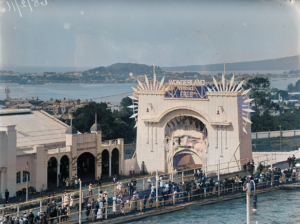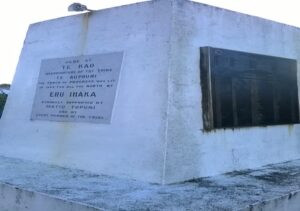1913: Walking To Happiness
January 3, 2024
By AHNZ
 Today in history, 3 January, 1914, 12 schoolboys arrived in central Auckland having walked 520km from their Far North home in Te Kao. They called it ‘The Great Trek’ and it had started on 13 December of the previous year. This was an educational trip thought up and planned by their primary school teacher, Joseph Banks. It was self-funded from the community and through the boys’ travelling performances on the road down and though the support and encouragement of sponsors from as far away as Christchurch and Wellington.
Today in history, 3 January, 1914, 12 schoolboys arrived in central Auckland having walked 520km from their Far North home in Te Kao. They called it ‘The Great Trek’ and it had started on 13 December of the previous year. This was an educational trip thought up and planned by their primary school teacher, Joseph Banks. It was self-funded from the community and through the boys’ travelling performances on the road down and though the support and encouragement of sponsors from as far away as Christchurch and Wellington.
The boys were walking out of a poor, muddy, primitive, and nomadic life based on gum digging and into the modern world itself. Along the way they encountered their first motorcar, train, and owned their first pair of shoes. “Each day more new sights and experiences sparked their interest. They stopped at farms and watched cows being milked by hand in a paddock. At another they saw a milking machine in action. They studied cropping, flax and timber processing and saw scows and steamships in the harbour.” Ref. Dragicevich (2021)
Banks wanted to open up a wider world to Te Kao through his school and through the 12 selected boys. He rather succeeded as the children learned first hand how other New Zealanders lived and took that back with them to their own homes. One of the boys grew up to be Reverend Jerry Hadfield (1899-78) who described this native school as the nerve center of his village and “seat of education” for the Te Aupouri tribe. Another of the 12 was Hemi Manuera who was so marked by the trip as to repeat the walk in 1964 calling it “walking back to happiness.” Ref. Keene (1974)
Hadfield (aka Herepo Harawira) claimed ancestors back 21 generations to the first canoe of the Te Aupouri tribe when they were still called Ngati Ruanui. In that case his people had lived in more or less the same place since about the year 1450AD so this Great Trek was a real landmark for a tribe as well as a generation.
What in the 2020s our culture frowns upon as “Colonisation” was eagerly sought after in the 1910s. Hadfield credits the Anglo-Zelandian school teachers with saving his community from the worst of the 1910 typhoid epidemic, for introducing new crops and musical instruments never known before. Mr and Mrs Banks even gave after school jobs and after-dinner night schooling to their Maori students to help them advance and find a better place in the new country. At the time the Hadfields were living a nomadic life in a house-tent made out of gum sacks for 8 kids. “There could hardly have been a less welcoming spot as Ngataki in 1899 for a boy to enter into this world,” he said.
“A school for native children is conducted at Te Kao by Mr. Joseph Banks, by whom the plans for the tour were made several months ago. He will accompany his scholars, who are from 10 to 16 years old, and are making their first excursion from their homes.” – New Zealand Herald (1913,) Papers Past
“Mr Banks and his party of Wiki Etana, Henare Etana, Tai Matiu, Waata Kapa, Hauraki Pako, Henare Pako, Kaipara Hemi, Wiki Karena, Hemi Manuera, Awarua Karena, Rihari Mere, Hamihana Poai and Heta Wi, set out on the great adventure on Friday 13 December. Miriam Henri, a young Maori girl, assisted the group by riding her horse and leading Mr Bank’s black mare Jemima with a pack-saddle carrying the boys’ costumes and gear. Some parents rode as far as Mangonui to see them on their way.” – Dragicevich (2021)
“Nathans provided us with dark blue serge shorts, blue flannel shirts and dark hose for town wear; Smith & Caugheys gave us white shirts and shorts for our concert uniform; George Courts supplied us with denim outfits for travelling; while the Zealandia company of Christchurch provided us with boots. Unfortunately we have never worn anything on our feet before…we were very proud of such rare treasures.” – Keene (1974)
 Auckland Mayor James Parr sent cars to collect the boys from Silverdale but they kept to their determination to complete the journey to Devonport ferry on foot. The performing children were well-received, sometimes their meals and accommodation paid for by the hosts while the Weekly News publicised each step of the way. From Takapuna the Takapuna Drum and Fife Band escorted the walkers into a massive crowd at Devonport which included the Chairman of the Education Board there to meet them. Crossing over Auckland Harbour, another band of musicians played the boys along Queen Street to the Domain where a Floral Carnival had attracted 14,000 people. Taking to the stage the boys performed their triumphant haka.
Auckland Mayor James Parr sent cars to collect the boys from Silverdale but they kept to their determination to complete the journey to Devonport ferry on foot. The performing children were well-received, sometimes their meals and accommodation paid for by the hosts while the Weekly News publicised each step of the way. From Takapuna the Takapuna Drum and Fife Band escorted the walkers into a massive crowd at Devonport which included the Chairman of the Education Board there to meet them. Crossing over Auckland Harbour, another band of musicians played the boys along Queen Street to the Domain where a Floral Carnival had attracted 14,000 people. Taking to the stage the boys performed their triumphant haka.
The dopamine and serotonin hits these Maori boys were copping were off the charts! Their hard work and good behavior as the chosen ones was being repaid by a country that loved them and welcomed them into their hearts. Armed with complimentary railway passes, they did more than see the Auckland Exhibition (free entry.) They continued to see Hamilton, Waitomo Caves, and to spend the 2 weeks in Mercer as the guest of Princess Te Puea. Then, they returned home by sea to a hero’s welcome back in Te Kao.
How could the future leaders of Te Kao fail to be inspired and attracted to take themselves and their community forward into progress and prosperity after a taste like this? Jerry Hadfield certainly did. He fought and trained men for two World Wars, including J Force. He held high posts in Maori Affairs and the Church and for 11 years the head welcoming elder at Waitangi Day each year. Ref. 1970s: Kiwis have no idea when the Treaty of Waitangi was signed, AHNZ
On the other hand, Jerry did hitch his wagon tightly to The State. According to his book the work he did involved helping Maoris get government grant money for marae and other hand-outs. It seems he had unlearned the lesson of independence and self-reliance that his people needed. Others kept to the light…
 It was just as well that Te Kao had Banks and his wife to lay this important groundwork because time was changing. The gum-based economy would run out and few communities are adaptive enough to find a new economic base to go on with as many once booming gold towns, now ghost towns, attest. Riverton, for example, was founded in 1850 by whalers who saw their fishery was running out so resolved save their town by transitioning from “ploughing the sea to ploughing the land.” Te Kao is another place that pulled off this minor miracle by taking on dairy farming. That got them another 90 years or so.
It was just as well that Te Kao had Banks and his wife to lay this important groundwork because time was changing. The gum-based economy would run out and few communities are adaptive enough to find a new economic base to go on with as many once booming gold towns, now ghost towns, attest. Riverton, for example, was founded in 1850 by whalers who saw their fishery was running out so resolved save their town by transitioning from “ploughing the sea to ploughing the land.” Te Kao is another place that pulled off this minor miracle by taking on dairy farming. That got them another 90 years or so.
Visiting in 2019 I found this monument (right) that reads “Here at Te Kao headquarters of the tribe Te Aupouri. The torch of progress was lit in 1925 for all the north by Eru Ihaka strongly supported by Matiu Tupuni and by every member of the tribe.”
“The institution of the Te Kao Dairying Scheme saved the district from starvation and ultimately resulted in the development of the Far North…Mr Watts, the native school headmaster, was made manager of the scheme. ” Ref. Theresa Sjoquist
By the 1940s there were “..37 farms around the locality, 46km south of Cape Reinga. But over the years the number has shrunk to just one, owned by Allie and Ngaire Wiki. And now, in the past week, the couple have closed their dairy farm for good..” – Gate shuts on farm tradition, NZ Herald (c.2013)
History now, despite these good efforts. Te Kao’s ‘light of progress’ is a deteriorating set of monuments and a little petrol station store. They’re not making money now. They’re wards of the Ministry of Social Development and exchanging their Work and Income government vouchers for food. It’s not in the spirit of The Great Trekkers who danced and sung their way on bare feet all the way to Auckland to bring the world home to their people. The major employment now appears to be the government health clinic looking after sick people.
Based on election returns for Northern Maori electorate, now called Te Tai Tokerau, the wider change seems to have started in 1938. Ever since then the Member voted in has been a grifter employing the politics of envy. Mat Rata, Tau Henare, Dover Samuels, Hone Harawira, Kelvin Davis, and now Mariameno Kapa-Kini. Farmers are not going to be able to flourish in an environment of welfarism.
—
Ref. Rangatira from Aupouri, Florence Keene (1974)
Image ref. The boys of the Great Trek, Northwood Brothers (Firm,) Kaye Dragicevich, Te Karere o Te Rarawa, Facebook (2021,) little colour by AHNZ (2023)
Image ref. Auckland Exhibition, A N Breckon, New Zealand Herald, Auckland Libraries Heritage Images Collection. coloured by AHNZ (2023)
 Like Comment Share
Like Comment Share





